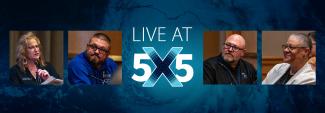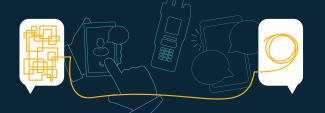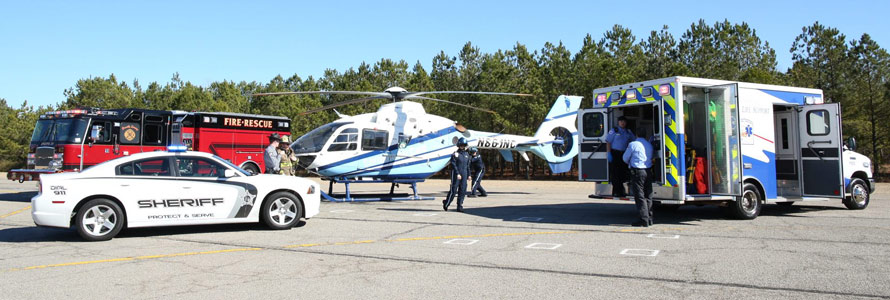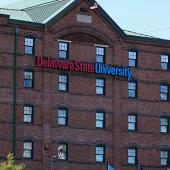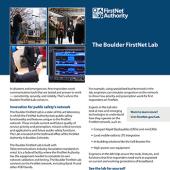Summary
In our latest episode of Public Safety First, host Dave Buchanan sits down with representatives of the FirstNet Authority Public Safety Advisory Committee (PSAC) Executive Committee (EC) to discuss how FirstNet is providing technological advancements, helping first responders look to improving the future of responding to incidents in Utah, Texas, Michigan, and Oregon.
Guest
Dave Buchanan
FirstNet Authority Executive Director of Public Safety Advocacy
Paul Patrick
FirstNet Authority Public Safety Advisory Committee Chair
Todd Early
Director of Communications from the Texas Department of Public Safety
Captain Mel Maier
Oakland County Sheriff's Office, Michigan
Chief Mike Duyck
Tualatin Valley Fire & Rescue, Oregon
Transcript
Preview
Narrator: You're listening to the Public Safety First, a podcast to help you learn about the First Responder Network Authority and how you can be part of the future of public safety technology.
And now your host, Dave Buchanan.
Narrator: You're listening to the Public Safety First, a podcast to help you learn about the First Responder Network Authority and how you can be part of the future of public safety technology.
And now your host, Dave Buchanan.
Dave Buchanan: Welcome to the Public Safety First podcast. Over the last several weeks, you've heard episodes where we've had terrific dialogue with public safety professionals that we met at app code and at the IAFC Fire and Rescue international conference where we heard firsthand about their use of FirstNet in the future of public safety communications. Today I'm joined by the Executive Committee of our Public Safety Advisory Committee our PSAC is made up of 43 individuals who represent professional organizations to represent various disciplines in public safety. The PSAC provides FirstNet with advice and expertise about public safety operations and a critical component to the operation of FirstNet. I'm first going to turn to our PSAC Chair Paul Patrick to talk to us a little bit about why you’re involved with the PSAC at all, and what excites you most about FirstNet?
Paul Patrick: Thanks, David. It really is an honor for me to be on the PSAC. I represent the National Association of State EMS officials, which is the organization that I recently served as the chair of. [I’m] very honored to represent all of the EMS Directors from all of the 50 states and the territories as we look at Emergency Medical Services as a discipline. I've been involved in EMS for over 30 years, originally volunteering in my community as an EMT, and being able to respond to various calls for emergency medical services, so it's been an honor for me to serve. Originally on the PSAC, I was one of the charter members of the PSAC and the executive committee and now as the interim chair. It's a pleasure for me to see how this group has progressed and moved forward in looking at the great strides of FirstNet but with AT&T has shown their commitment to public safety, to public safety communications, and to the issues that EMS needs, and also is looking forward to as we move into the future. So FirstNet is obviously a great opportunity for emergency medical services to move forward in the future.
Dave Buchanan: Today, we spent some time planning for our work in 2019. I'm personally excited about the partnership we have with the PSAC and the work we're going to be able to do together. Paul talked a little bit about what you think are some of the different things the PSAC is going to be able to do for FirstNet as we work together to bring about the very best First Responder Network.
Paul Patrick: I know we were all excited as we looked at opting in and opting out, and that became the focus for several years as we move forward and, once we reached that milestone, and contracts were established, and we've been moving forward. As a PSAC we’re changing our focus now to help the 43 members of the Public Safety Advisory Committee now be more of an advocate for their network—our network. I call it my network but it's really our network as we move forward in public safety. And as our network helps us to achieve the most amazing things that we haven't even come to grips with yet in Emergency Medical Services as we're looking at such things as being able to transmit data that we've never been able to before—not just video, but data from a patient, information about the patient, even getting into potentially—and we've always done EKGs which is an electrocardiogram—but being able to dive into the world of potentially sonograms or what's at the incident and be able to help guide patient decisions. Those are exciting things for us in our field to be able to realize it to a patient receiving facility. We can give them more current updated information on a single patient, mass casualty, and major incidents and things that happen out there. We'll be able to not only sort and sift, but be able to get the right patient to the right facility in the quickest time possible so that they can get the best care and, hopefully, recover from whatever their injury illness or accident is. In 1972 when Johnny and Roy, from the TV show Emergency With Squad 51, would respond to do things that were totally Hollywood—real Star Trek-ish as you would like to say: We never thought it would happen, but now with FirstNet all the things that they did and a lot of what's on Star Trek is actually a reality. And to answer your question about where PSAC is going in 2019: We've been planning ahead. One of the things that we're excited about is that we need engagement from all 43 of the PSAC members. We need every member to be able to understand the network—it's their network, its public safety's network--be able to answer questions and help us take that message out to all their associations. We have some pretty exciting things coming up to be able to do that next year to help that message get out.
Dave Buchanan: Thanks Paul, that's terrific. Todd Early has been around FirstNet for a long time. He's been the Single Point of Contact from the state of Texas since 2013. He's currently the Director of Communications from the Texas Department of Public Safety, and he also served the last couple years on our PSAC executive committee. Todd, your department is one of the largest, if not the largest, customer of FirstNet in the nation. You've been operationally involved in the deployment of FirstNet. Can you talk a little bit about that experience and what that's been like for you and your colleagues in Texas?
Todd Early: Thanks, Dave. You know, we've had the opportunity to deploy and also activate some of the response assets of FirstNet over the past five or six months at least five times. Several of those were on wildfires in Texas, and two of those were on shooting incidents in Texas. FirstNet has really allowed us in public safety from the communications side to really become proactive in communications planning and historically we've been reactive, and what I mean by that is historically we have always responded to the need once the first responder got down range and had issues with communicating. Now that we have FirstNet we have become proactive, so when any incident happens, one of our first reactions from the communications planning side is really to make a proactive call. We find out information about the network, the coverage in that area, decide whether we need deployable assets to respond, and we make those calls right up front, so that when the responders are in route to the incidents, we're able to provide them a lot of information to their fingertips, so that they can communicate when they get to that incident. During the recent wildfires, we deployed FirstNet deployable assets to those locations to assist with coverage in the area, and what it really allowed us to do for the first time in deploying some of those wildfire assets we were able to take cashed up FirstNet devices and put them inside the mutual aid fire assets that were responding, and for the first time we were able to actually geo-locate and track those fire trucks and wherever they were at responding to those wildfires on a GPS map and really that provided us situational awareness into where the different assets were at, where the locations were at and something that we've never had in the past when it comes to wildfire response. In regard to the other two incidents when the shooting incidents happen we were able to immediately find out information about the network we were able to find out if those locations had coverage, didn't have coverage we made calls and were able to respond deployable assets to those locations to ensure that we had the coverage and the bandwidth that we needed in those locations, but it also helped us in the planning where we put our command post because historically we typically put a command post in a location and then we tell everybody where that's at. Now that we've really changed the paradigm of the way we respond we're able to make sure that the locations that we select have the right coverage that these locations provide the necessary abilities that we need to put those command post and provide the resources to the responders when they get to those locations.
Dave Buchannan: I know in Texas you really emphasize collaboration with local public safety you've conducted a lot of outreach and education and it's a big part of the way you're operating now that FirstNet’s operational, what kind of questions are you getting from those across the state and what kind of questions do they have today about FirstNet that might be different than the questions they are asked in a year or two years ago or before that?
Todd Early: Well, they've I think there's really an air of excitement. Public safety has long advocated for this network, they've needed they deserve this network and we have really gone from conceptual network to a network that's being deployed and in actuality being deployed much faster than what any of us in public safety you know really ever expected, and really a lot of the questions that we get now or ‘what's the coverage look like?”, “What am I going to get the coverage if I don't have it?”, “What's it going to cost me?”, and “How soon can I get it?” because as public safety hears these use cases as Public Safety learns of the technology and the innovation that this is going to put in the hands of the first responders they're very excited about it and they want it sooner than later.
Dave Buchannan: I thought we had a great dialogue this morning about the future of the piece PSAC and how we're going to continue to work together to advocate for public safety. In our mutual goal of making this the best network it can be for first responders, talk a little bit about what you hope we can achieve together and how we might continue to drive this forward to make sure we're getting the right inputs from public safety and we work together on that.
Todd Early: You know Dave, it's really truly an exciting time and being able to take a look at this and what information that the PSAC and the representations of these associations can provide to the build- out of this network you know we talk a lot and have historically over the past several years talked a lot about network and we've talked a lot about priority and preemption, but when you really look at the innovation that this networks going to put in the hands of our first responders, it's going to provide tools and technology that we have never even thought about. And one of those things is solutions driven and now what solutions can FirstNet provide to public safety first responders that we've never had or that we've never thought about that can help fill the gaps of the needs of our first responders and the things that they deal with whether it's hurricanes, wildfires, everyday operations to make sure that that what is put in their hands what the innovation that comes out of it and the focus that's put on this network is really received from input from public safety first responders in these very important associations that are on the PSAC.
Dave Buchannan: I want to turn to Mel Maier from the Oakland County Sheriff's Office. Mel represents the Major County Sheriffs of America Organization on our PSAC, and Mel, Oakland County from my perspective has been a leader in Michigan and a leader really across the country in working through law enforcement communications issues, interoperability issues, for the last 20 years know this has really been a central piece of your Sheriff's mission is to improve communications. You recently became a FirstNet customer can you talk a little bit about what that has been like and that how that changes affected the Oakland County Sheriff's Office?
Mel Maier: Absolutely. Dave, it's very exciting for us to do this, it's something we've been working for for many many years. So one of the first things that we did is we got with our local AT&T; FirstNet representative Brent Schroeder, and when Brent and I sat down to really talk about what we want to start doing with our hundreds and hundreds of mobile data computers, all of our handheld devices, all the things that we're putting out in the field where do we start? We started with some handheld devices where iPhones. We took the iPhones and we started switching over about a hundred at a time and I got to tell you, the excitement when we had these guys out in the field started turning on their phones for the first time seeing that FirstNet logo pop up on the screen and knowing that they had a dedicated network built for them that has priority and preemption built-in it was exciting. I know that when I got my phone, I got to tell you, when I turned it on I was super excited to see that it actually was getting the bandwidth speeds in a crowded room full of people, hundreds of people and I never had a problem streaming video coming off one of our video servers. That's just unparalleled for us in the past we couldn't get it didn't work we have big arenas, we have hundreds of thousands of people using this our deputies are out there using these handheld devices for the first time they actually had dedicated bandwidth, they got the data. So the second thing we did is we started working with some of our partners so they came in and we bought a couple hundred sound devices and started putting them out in the field I got to tell you it's a great device for us because it's hardened it works out in the field the guys can abuse them a little bit and they take the abuse. For the sheriff it was just getting the information that he wanted the road patrol deputies to have in real time. Before we had to queue up we had to wait sometimes we didn't even get on the network because there was too much traffic. Now with AT&T’s FirstNet and our FirstNet network, were getting it. We're on board. We used it recently with the Woodward Dream Cruise we had over a hundred thousand people lined up and down Woodward and over the course of three days, about a million people. And yet inside that area we had video from our helicopters, streaming down to the first responders on a road. We had first responders using applications being able to send situational awareness to each other incidents going on in and around the activity real time. We have never been able to do that it's very exciting for us. When we started looking at things like our on it unmanned aerial vehicles, we started putting the UAVs up and we're sending the video back with FirstNet service, it's improved it greatly in the quality of the videos what we're talking about, instead of getting a low-definition signal we're getting high-def signal. We can actually see what we need to see. This is for the first time where we've been able to say that. Next we started looking at some of the more unique things we do with our robots and some of the sensors and devices we have on the field, but I got to tell you the most exciting part for us has been this new biometric application that we're putting out in the field, it's called “Blue Check,” and we use that to access a fingerprint database. That hooks up and back feeds through our mobile data computer, Wi-Fi and LTE signal. As we start putting these FirstNet deployed vehicles out in the field with these blue check devices, we're looking to eliminate and as well as capture people that need to be arrested when they would try to verify their identity. If you're not who you say you're sure somebody trying to hide your identity, or to find you that's cool stuff.
Dave Buchannan: So describe that application a little more what how did you used to conduct at that effort and how has it improved now that you have FirstNet?
Mel Maier: Well, with FirstNet service, we've got is dedicated bandwidth. Instead of waiting in line for us to get data as it pushes through and we have to keep units out on the field tied up waiting for information come back, we're able to push large files across the LTE airwaves and it gets to the patrol cars where they need to go. And that was not possible with our other service because we were just another customer.
Dave Buchannan: You've been a member of the PSAC since 2014. You recently joined our Executive Committee, we work today to plan out some of the things we want to work on together in 2019. Tell me a little bit about what you're most excited about in this partnership with the PSAC and the First Responder Network Authority.
Mel Maier: Well, Dave, coming from where we were in a planning phase and putting task teams together, where in fact we were just trying to plan on best practices, use case scenarios to help design this network, into actually using it this quick it's not imaginable for me at all sitting here five years ago thinking about what we can do with FirstNet. We are so far beyond that now what we can actually do is start planning on new applications new, services new database connectivity, and the sharing of data as we move forward the role the PSAC is really to help give the FirstNet authority the ideas the priority is that we want to see these rolled out, whether it's going to be about situational awareness real-time geolocation data, whether it's about sensor data all those other things, that's where the piece that comes into play. And when I look at the law enforcement folks that I represent out there whether it's through the Major County Sheriffs, the National Sheriffs, all the other associations with the Major City Chiefs, IACP, these people have such a wealth and depth of knowledge that they're ready to do it and give it to Firstnet Authority to help make those prioritizing decisions. Especially when we're talking about investment. If we're looking at investing dollars in towers in a location to bring up better coverage so be it. But if we're talking about developing an application, a suite of applications, they actually help situational awareness getting data out to the field, creating API’s that allow disparate systems to connect to each other through the cloud, in a secure database with CJIs level grade safety, that's a win, and that's where the PSAC is going to help because we're to help prioritize what needs to get done and we're going to work with the folks are the asset one of the best partners you could have picked AT&T; and I got to tell you I think about it as a force multiplier. When I think about the feet on the street, the information that they need, what you've done with the FirstNet Authority, what we've built with our FirstNet network and now what our partner AT&T, we're doing pretty good
Dave Buchannan: Thanks Mel, really appreciate that thanks for your time today.
Mel Maier: No thank you, sir.
Dave Buchannan: I'd like to now turn to Chief Mike Duyck, our newest member of the Public Safety Advisory Committee. Chief Dyke, what made you want to get involved the FirstNet Public Safety Advisory Committee.
Chief Mike Duyck: Thanks so my name is Mike Duyck. I'm the Fire Chief at Tualatin Valley Fire & Rescue and I represent the Metropolitan Fire Chiefs Association on the PSAC. It was a great opportunity to get involved I replaced Chief Mouths forward from Baltimore this last June, and for me it was a great opportunity because I know with all of public safety across the country helped play our part in getting FirstNet to begin with, the d-block and the public safety spectrum. Then at our local level in my state of Oregon, I chaired the committee that did the State Plan Review and recommend it to our governor to opt in. I sat on SAFECOM, so I played a role in that piece representing the Metropolitan Chiefs in that venue also, and really to kind of go full circle now to be a member of the PSAC and provide input back to FirstNet on what our network needs as we build it out over the course of the next 25 plus years. It's a great opportunity to represent my association, my industry, and really you know move it towards what public safety needs into the future.
Dave Buchannan: What do you think as you look across your profession, the fire services profession, what do you think are some of the most important attributes that your colleagues see in FirstNet and what about that you think is most exciting for your colleagues?
Chief Mike Duyck: One of the pieces that I think is the most important is it's our network. It’s a public safety network that's built to the level of reliability and capability that we need and that's going to open opportunities for us that we've never had. we've been reliant on commercial networks and for those reasons you know we've never really thrown a lot of mission-critical functionality behind what we were asking from it I think in the future we'll be able to actually put those mission-critical tasks you know and focus them on the network and I'm excited to see how Public Safety in the future will leverage it to make us more efficient more effective and make our firefighters safer in the work they're doing.
Dave Buchannan: Earlier today during our planning session we had a chance to talk a little bit about location-based services and how important that attribute is going to be for the fire services and really for public-safety at- large can you talk a little bit about that particular aspect of FirstNet and how important that's going to be for the fire services profession.
Chief Mike Duyck: Absolutely. Location-based services I mean everything resides with that in the actual incident location itself there's so much data that exists today that we can bring to the hands of our responders where they're going, what's their other layers of data geospatial data in some cases, pre plans information about the buildings and the environments they're going into. When you have the responders connected to the FirstNet network they'll bring the location-based services of themselves, where they're actually at. This would be the first time in history where an incident commander could sit outside of a building and know where firefighters actually are inside that building during firefighting operations. Down to you know all the other data that can be collected biometrics. I mean the list really goes on and on on what location-based services will bring to us, and it's frankly an exciting day to be able to start to walk down some of those technological advance advancements.
Dave Buchannan: We're all seeing firsthand in the news every single day about the tragedies associated with the wildfires out west. As a Western Fire Chief can you give us your perspective about those experiences and what that's like?
Chief Mike Duyck: Yes. I can, so yeah the West is experiencing in some cases unprecedented fires, largest in some of the state's histories. And you know it's what's been great this summer is we have FirstNet, and FirstNet is leaning forward even though by contract they weren't going to have some of the resources the SatCOLT and other things available until the fall. They’re using their cement business as usual' assets and deploying them on FirstNet as FirstNet to some of the fires, and the incident commanders and in the wild fire firefighters and our structural folks that are showing up to do structural protection are leveraging those assets and the FirstNet network to push live information between the command staff and the frontline firefighters doing structural protection, where exactly is the fire what you know , videos of fire behavior and the type of combustibles that the fire is moving through. It's something that according to you know one of my assistant Chiefs, who's an incident commander for one of the state teams, they've never had that amount that level of data and that amount of situational awareness at their fingertips. So I'm excited because it makes our firefighters more effective. The command staff can better plan for resources they're going to need to get ahead of the fire and to stop the loss of life and loss of property, and our firefighters operate in a much safer environment when they can be told what's happening, live weather conditions, I mean everything you can imagine that comes with a data network that's public safety grade that's being put in the hand in their hands in the field. So we've been really pleased with the response from FirstNet. We had several fires that they've come out in the most recent they actually position the SatCOLT to where they had full coverage over the entire fire footprint and that gave the wildland crews and the firefighters that were fighting that fire direct connection to the command post in a high level and a high data speed to be able to share a lot of information back and forth.
Dave Buchannan: Can you talk a little bit more about the next generation of Public Safety professional what are their expectations for FirstNet?
Chief Mike Duyck: Well, their expectation is that they're surprised that it wasn't already here and it wasn't being utilized in public safety. I've had several times when police chiefs and fire chiefs have said “Well, I'm not that interested because my organization doesn't use broadband data,” to which my answer is usually, “Well you know you don't realize what your boots on the ground are actually using, they're just using their own device not the device that you give them.” So what I've seen is we've we put it hardware in their hands, smartphones and tablets, and then just said “use it.” We haven't given a lot of specifics but that next generation comes up with ideas on how to actually use different applications to be more effective at their job on their own. Long before we had any kind of Street mapping application or a pre-plan operation application they were using Google Street View to pull up a front view of a building and do as much of a 360 view of that address that they were responding to you to know prior to arrival if it was a residential fire, where were the bedrooms, was it a split-level, was there anything to get from the aerial view, and they were actually chalk talking what they were going to do the second that they parked the apparatus before they even got there by just using consumer applications that they could get their hands on. We deployed tablets and they just started using them. That's what they do they've always grown up in environments where they've had technology in their hands they've always had they grew up we went through high school with a smartphone and they text, they do a lot of things that we didn't do early on in my career, but now since they've always grown up that way the expectation that they come into the public safety service is that we have at that for them and they want to use it. So they are actually our biggest champions and come up with what's the greatest, they've come up with the greatest ideas on how we should be using technology and public safety on that FirstNet network. So one of the questions we get asked is- FirstNet’s new it's rapidly evolving and changing how do we get this information in the hands of first responders you know that the Chiefs of the departments are getting information and those that may subscribe to newsletters or see the information on social media may see it, but that's not everybody. Most organizations like ours have some sort of electronic learning management system. We specifically use Target Solutions, which is one of those learning management systems but they provide the ability to upload content of all types, videos, and podcasts to different information and then push it out to all the first responders, and then it records when they when they actually viewed it or consumed the information. They can put tests if they wanted to make sure they actually understood the information they received, and that's just a great mechanism to make sure that the information that first responders need about FirstNet and about, what's happening with this this opportunity for public safety gets in their hands so they understand it. And they can provide feedback back up through their chains of command on what they'd like to see too. So it's a great way to get this done in a very, very efficient manner throughout each and every organization across the country.
Dave Buchannan: Thank you, chief I appreciate your comments today. In an upcoming episode. We're going to learn about the engagement we had with the city of Richmond, Virginia, their use of data and how they are optimizing their operations through FirstNet.
Narrator: Thanks for listening today. We're excited to have you join our podcast community and make sure to subscribe on iTunes, SoundCloud and YouTube. You can learn more about the First Responder Network Authority at firstnet.gov and learn about FirstNet products and services at firstnet.com.



